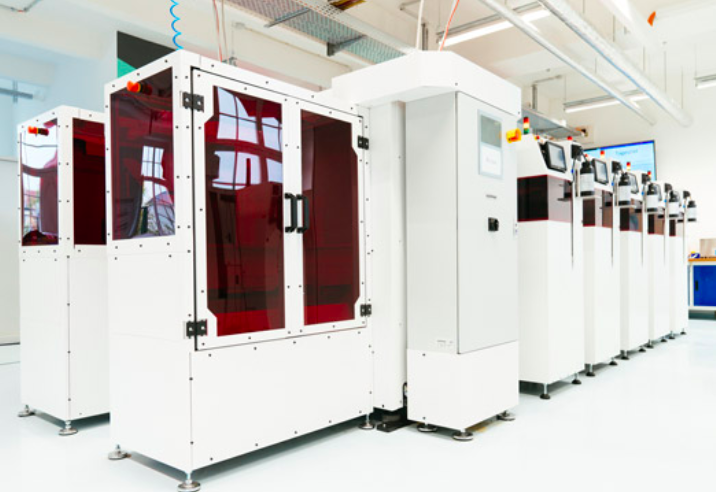Our series looking at additive manufacturing with VAT photopolymerization continues with insights from Karsten Müller, Sales Director, Rapid Shape GmbH, Germany.
Based in southern Germany, Rapid Shape has over ten years of experience in specialized 3D printing systems for dentistry, hearing aids, jewelry, and industrial markets. With 3D printing systems including the I50+ and I100+, Rapid Shape provides a range of solutions from prototyping to production.
We need your insights. How do you see the resin 3D printing market and where can improvements be made? Take the Spotlight on Resin 3D Printing survey now.

3DPI: How have you seen resin-based 3D printing develop in recent years?
Karsten Müller: Even three to four years ago, we haven’t seen real applicable resin out there in the market for industrial use. Photopolymer resin always was to be used for prototyping topics. In other words, this meant: hard, rigid output. This has changed. Now there are resins available that are elastic, UV-Resistant, and as well flexible. So now the output of the VAT-printers really can be used for producing functional parts for pre-series or even the entire end-product.
3DPI: What do you consider the next technology hurdles for photopolymer-based 3D printing to overcome?
Karsten Müller: The next step will be the spread of VAT printing as a standard production process. This means that this additive manufacturing process will shape the everyday work of dental labs and production facilities in terms of width and high demands on speed and reliability. VAT printing will become a matter of course.
3DPI: What applications of vat photopolymerization do you see as under-developed by the market, and why?
Karsten Müller: In general, it can be said that dental models already have a high market penetration. Digitally prepared and printed splints or guides are increasingly gaining ground. The increased use of printed dentures and full dentures is certainly possible as the next step.
3DPI: Where are opportunities for materials development in regards to vat photopolymerization technology?
Karsten Müller: The opportunities are in complex structures (lattice), lightweight design, elastic materials.
3DPI: What LOCTITE resins are validated on your printing platforms?
Karsten Müller: Many – to go by Loctite’s statements, there is no manufacturer that can offer more material compatibility than Rapid Shape with its open material system. If you would like to receive any further information on this topic feel free to follow the link.
3DPI: What applications are end-users leveraging using LOCTITE 3D resins on your platform?
Karsten Müller: The use of Henkel materials results in a variety of applications. The automotive industry, as well as aircraft manufacturers, beverage and food producers, the healthcare sector, sporting goods producers, and others, rely on the material properties of Loctite.
3DPI: Can you explain the value that LOCTITE 3D resins bring to your platform? How does this complement your existing/ proprietary material portfolio?
Karsten Müller: Rapid Shape prefers to offer an open material system to provide the broadest possible benefit to customers. However, to ensure validated workflows, Rapid Shape is committed to maintaining a very close relationship with some material partners. We, therefore, offer a very large library of materials together with our material partners (including Henkel).
3DPI: Have you worked with LOCTITE to develop customized materials? If so, can you describe the collaboration process?
Karsten Müller: Both research and development teams undertook different parts of the validation. There was an intensive, regular, and fruitful exchange with the Henkel team in Heidelberg around Dr. Daniel Rothfuss in particular.
3DPI: What LOCTITE resins have seen the most interest/use on your platforms? Any insight into why this might be?
Karsten Müller: The beauty of the Henkel portfolio is the combination of very specific, but also general-purpose materials. The totality of the range for a wide variety of applications is what makes the value, in our view.
3DPI: How do you anticipate your printer platforms that leverage Loctite resins will grow in 2022?
Karsten Müller: Rapid Shape has been observing a continuous increase in resin consumption in almost all areas for years. We are therefore assuming a significant double-digit percentage growth here.
Take the Spotlight on Resin 3D Printing survey now.
Make sure you don’t miss the results. Sign up for our free newsletter for the latest news in additive manufacturing. You can also stay connected by following us on Twitter and liking us on Facebook.
Looking for a career in additive manufacturing? Visit 3D Printing Jobs for a selection of roles in the industry. Subscribe to our YouTube channel for the latest 3D printing video shorts, reviews, and webinar replays.
Featured image shows several of Rapid Shape’s RS inline systems connected together. Photo via Rapid Shape.



